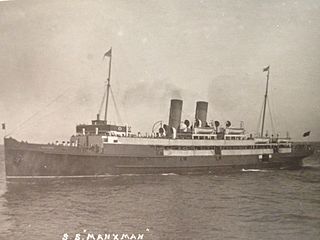Related Research Articles

The Hull Barnsley & West Riding Junction Railway and Dock Company (HB&WRJR&DCo.) was opened on 20 July 1885. It had a total projected length of 66 miles but never reached Barnsley, stopping a few miles short at Stairfoot. The name was changed to The Hull and Barnsley Railway (H&BR) in 1905. Its Alexandra Dock in Hull opened 16 July 1885.

Ellerman Lines was a UK cargo and passenger shipping company that operated from the late nineteenth century and into the twentieth century. It was founded in the late 19th century, and continued to expand by acquiring smaller shipping lines until it became one of the largest shipping firms in the World. Setbacks occurred through heavy losses to its merchant fleet in the First and Second World Wars but were overcome in each case.
Thomas Wilson Sons & Co. was a British shipping company, founded in 1840, It evolved from a joint venture formed by merchants Thomas Wilson, John Beckinton and two unrelated partners named Hudson in 1822.
Earle's Shipbuilding was an engineering company that was based in Hull, East Riding of Yorkshire, England from 1845 to 1932.

The Port of Hull is a port at the confluence of the River Hull and the Humber Estuary in Kingston upon Hull, in the East Riding of Yorkshire, England.

TSS Manxman was a turbine steamship launched in 1904 for the Midland Railway and operated between Heysham and Douglas, Isle of Man. In 1916, she was commissioned by the Royal Navy as HMS Manxman and saw action as a seaplane carrier during the First World War, after which she was acquired by the Isle of Man Steam Packet Company. On the outbreak of the Second World War she was again requisitioned as a troop ship, until she was commissioned and her name changed to HMS Caduceus. She never returned to Manx waters, and was scrapped in August 1949.

The Baltimore Steam Packet Company, nicknamed the Old Bay Line, was an American steamship line from 1840 to 1962 that provided overnight steamboat service on Chesapeake Bay, primarily between Baltimore, Maryland, and Norfolk, Virginia. Called a "packet" for the mail packets carried on government mail contracts, the term in the 19th century came to mean a steamer line operating on a regular, fixed daily schedule between two or more cities. When it closed in 1962 after 122 years of existence, it was the last surviving overnight steamship passenger service in the United States.
PS Ocean was a paddle steamer built for and operated by the St. George Steam Packet Company from 1836, then the Cork Steamship Company and then the Chester and Holyhead Railway from 1853 to 1859 and the London and North Western Railway from 1859 to 1862.
Associated Humber Lines (AHL) was created in 1935 to manage the services of various railway controlled shipping lines including port activities in the Humber area of the United Kingdom. The ownership of the respective vessels did not transfer to A.H.L and similarly the ports concerned, Hull, Goole and Grimsby, also remained under the control of the railway companies and their successors.
Wilson's & North Eastern Railway Shipping Co. Ltd was formed in March 1906 in England by the family who controlled Wilson Line of Hull and the North Eastern Railway Company.
The following is a timeline of the history of the city of Kingston upon Hull, East Riding of Yorkshire, England.

SS or RMS The Ramsey was a passenger steamer operated by the Isle of Man Steam Packet Company from 1912 to 1914. She had been built in 1895 as Duke of Lancaster for the joint service to Belfast of the London and North Western Railway and Lancashire and Yorkshire Railway companies. The steamer was requisitioned by the Admiralty in 1914 as the armed boarding vessel HMS Ramsey and sunk the following year.

The General Steam Navigation Company (GSN), incorporated in 1824, was London's foremost short sea shipping line for almost 150 years. It was the oldest shipping company in the world to begin business with seagoing steam vessels.
TSS City of Belfast was a passenger steamship that was built in England in 1893, renamed Nicolaos Togias in 1925, renamed Kephallinia in 1933 and sank in 1941. She was owned and registered in Britain until 1925, when she passed to Greek owners.
SS Berlin was a freight vessel built for the Yorkshire Coal and Steamship Company in 1891.
SS Douglas was a freight vessel built for the Clyde Shipbuilding and Engineering in Port Glasgow for Goole Steam Shipping Company in 1907.
SS Equity was a freight vessel built for the Co-operative Wholesale Society Limited in 1888.
SS Ralph Creyke was a passenger and freight vessel built for the Goole Steam Shipping Company in 1879.
The Lancashire and Yorkshire Railway (L&YR) had the largest fleet of all the pre-grouping railway companies. In 1902 the assets of the Drogheda Steam Packet Company were acquired for the sum of £80,000. In 1905 they took over the Goole Steam Shipping Company. By 1913 they owned 26 vessels, with another two under construction, plus a further five under joint ownership with the London and North Western Railway. The L&YR ran steamers between Liverpool and Drogheda, Hull and Zeebrugge, and between Goole and many continental ports including Amsterdam, Copenhagen, Hamburg, and Rotterdam. The jointly owned vessels provided services between Fleetwood, Belfast and Derry.

Agwilines Inc was a passenger and cargo shipping company of New York City. Agwilines is short for Atlantic, Gulf & West Indies Steamship Inc. AGWI Lines group operated four main lines in the 1910s, 1920s and 1930s:
References
- 1 2 3 4 5 Haws 1993 , p. 139
- ↑ Greenway 1986, p. 66.
- ↑ "SS Millet". The Wrecksite. Retrieved 25 November 2017.
- ↑ "Maidos and Bulair Destroyed". Hastings Standard, Volume IV, Issue 442. 18 May 1915. Retrieved 10 January 2018– via Papers Past, National Library of New Zealand.
- 1 2 3 Haws 1993 , p. 140
- ↑ "SS Minister Tak Van Poortvliet". The Wrecksite. Retrieved 25 November 2017.
- ↑ "SS Colombia". The Wrecksite. Retrieved 25 November 2017.
- 1 2 3 Haws 1993 , p. 141
- ↑ "SS Rievaulx Abbey". The Wrecksite. Retrieved 25 November 2017.
- 1 2 Haws 1993 , p. 142